Paris Saint-Germain’s positive start to the Ligue 1 season may suggest another unchallenged title campaign. However, upon taking a closer look, life is far from normal at Le Parc des Princes. Kylian Mbappé’s new contract earlier this summer symbolised the beginning of a new regime in Paris.
Firstly, Leonardo and Mauricio Pochettino’s departure saw the introduction of a new Director of Football, Luís Campos, and a new manager, Christophe Galtier. In addition to the recruitment and development of several stars, the former Lille duo were responsible for Les Dogues’ historic 2020/21 Ligue 1 title. With numerous changes in conduct and strategy, the new leadership has seemingly brought order and identity to a disoriented PSG side.
Mbappé’s new contract saw him become the face of this project, but unsurprisingly, this has resulted in conflict, more specifically with Neymar. The media’s constant speculation throughout the summer has certainly aggravated the situation. Nonetheless, against Montpellier, the two were visibly disconnected. The management of egos at Le Parc des Princes will undoubtedly be Galtier’s most difficult challenge, and perhaps the deciding factor in their desperately sought-after continental success.
While PSG’s cohesion, or lack thereof, is under the microscope, their new tactical identity under the French manager has been promising. The former Lille and OGC Nice manager has introduced a tactical system whereby individual talent is the driving factor, while still maintaining collective structure and discipline.
This tactical analysis will take an in-depth look at PSG’s tactics under Christophe Galtier. In addition to observing their structure and behaviour in possession, this analysis will consider how Galtier’s tactics look to be getting more out of Lionel Messi and Neymar than last season’s system.
Finally, we will look at the tactical impact of Mbappé’s recent return to the team, highlighting the challenges the French manager will face in integrating Kylian into his fluid system.
Structure
The first significant change made by Christophe Galtier was the shift to three centre-backs. This setup not only allows them to use their three main centre-backs at the same time, but it optimises Sergio Ramos and Presnel Kimpembe’s ball-playing abilities. With Marquinhos providing cover, the two have the freedom to support their respective wings in possession and create numerical superiority.
Ahead of them, a line of four is comprised of Achraf Hakimi, Marco Verratti, Vitinha, and Nuno Mendes. The two wing-backs have an important role in possession, responsible for maintaining width and providing support in the final third. In the middle, the dynamic created by Vitinha and Verratti’s individual characteristics allows for a balanced and effective partnership.
In the first few matches of the season, Pablo Sarabia was the immediate replacement as Mbappé recovered from injury and served his suspension. As a result, Galtier adopted a front three structure of Messi, Neymar, and Sarabia. The dynamic between the three was rather effective as Sarabia’s willingness to provide depth and constantly attack the backline allowed for freedom and space in between lines for the two stars.
Their average positions in the first match of the season against Clermont allowed for a more accurate illustration of their structure. While the centre-back trio is quite spread out with the two wide centre-backs providing support on the wings, the wing-backs are responsible for maintaining width. The front three, then, is extremely narrow, constantly interacting with the midfielders.
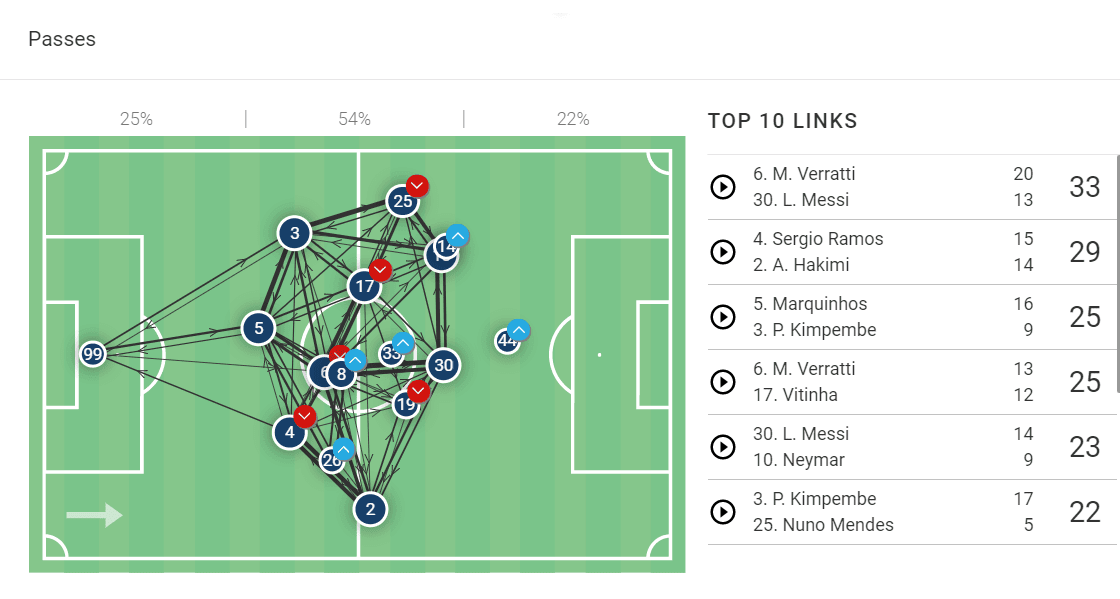
Mbappé’s return against Montpellier resulted in a slight change in structure, as the French star has completely different characteristics from Sarabia. The 3-4-3 turned into a 3-4-2-1, with the 23-year-old playing ahead of Messi and Neymar.
Throughout the match, Mbappé naturally shifted toward the left wing, where he is most comfortable. This not only resulted in an overwhelming focus on the left, as seen below, but it also introduced a new problem for Galtier. This system, which appeared extremely fluid against Clermont, makes it difficult for Mbappé and Neymar to coexist. The dynamic created by the two brings a tactical challenge for Galtier, which we will explore in-depth later in this analysis.
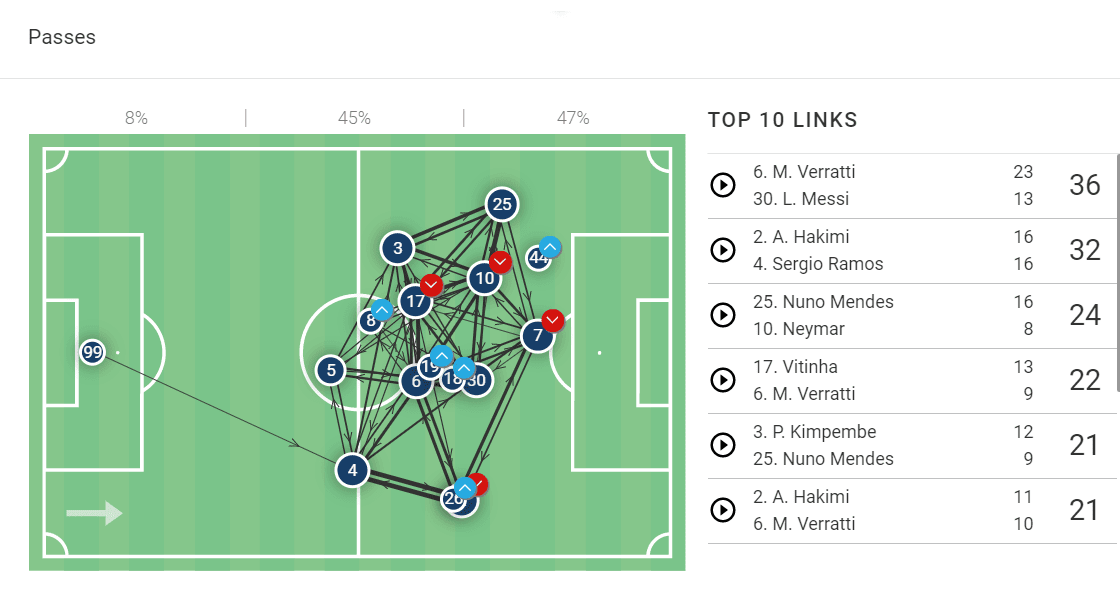
Fluidity
In addition to the structure, there has been a drastic change in PSG’s behaviour with the ball under Galtier. There are a few principles that characterise this side, and these ideas have been increasing in popularity this year. From a broader perspective, Galtier’s tactics are characterised by freedom, extreme fluidity and mobility.
The first strategy adopted by this new PSG is numerical superiority. Although this is fairly common throughout the top clubs, it is far more extreme in Paris. With the ball as the focal point, players will move collectively through the pitch, flowing in and out of passing lanes.
Especially in the build-up, this will attract a significant number of opposition players to a certain area. After luring the opposition to one side, they will quickly play out of this zone, as they have superiority, and attack the free space on the other side.
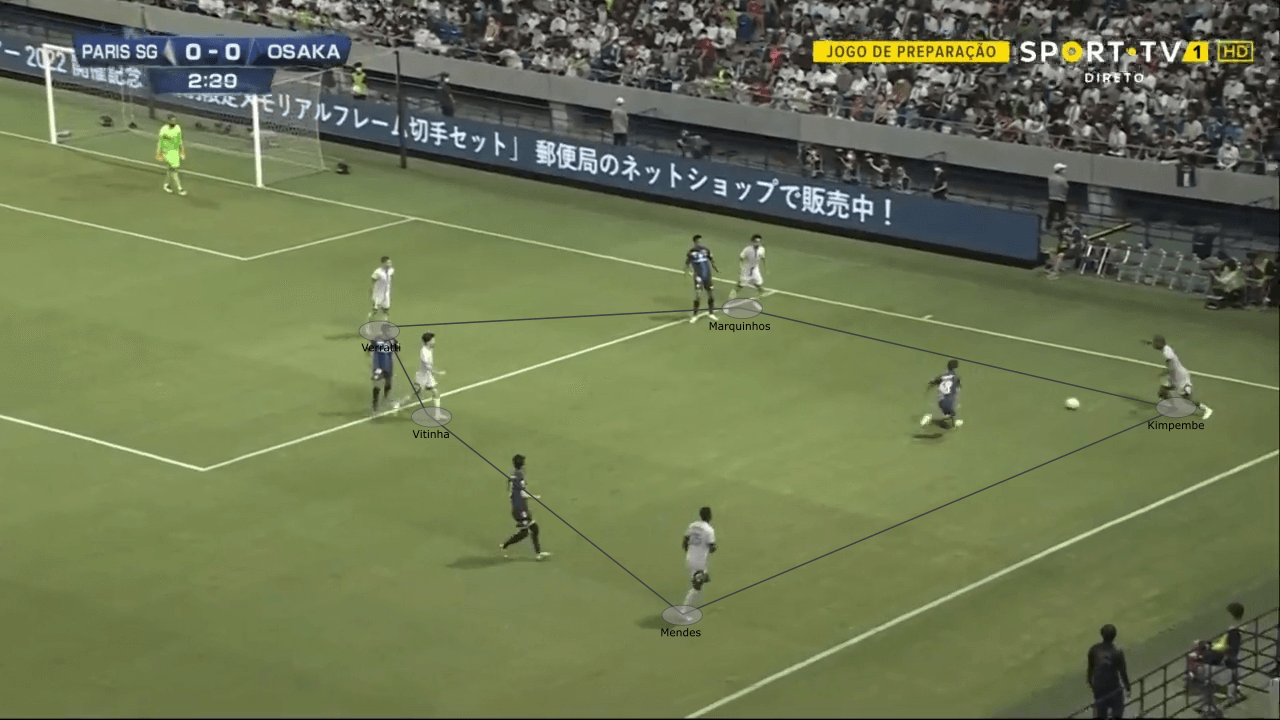
In this system, constant approximation is necessary. Rather than having players strategically distributed throughout the opposition’s half, Les Parisiens will constantly provide support around the ball creating numerous passing lanes. As a result, their passing style is much shorter but at an incredibly high rate. Players are able to constantly combine and interact with each other. With so many creative and technical players, this is highly effective.
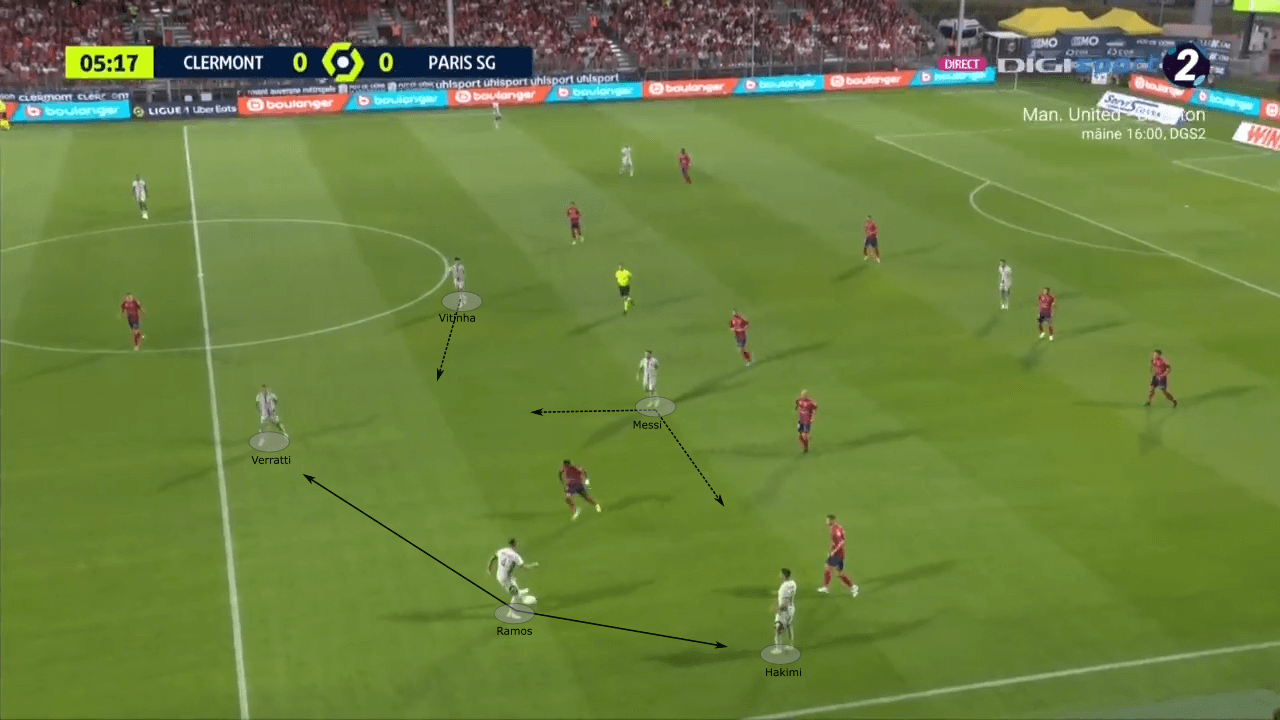
Rotations have also been extremely common under the former Lille manager. Impressively, the players have demonstrated great coordination in naturally flowing among positions and roles. In the example below, Ramos drives with the ball all the way into the final third. As he passes it wide to recycle it, Verratti drops into his position and Messi becomes the second midfielder.
As they rely on relentless approximation around the ball, constant movement is necessary. So as not to become predictable and static, players will rotate positions and roles to disorganise the defensive structure and create space.
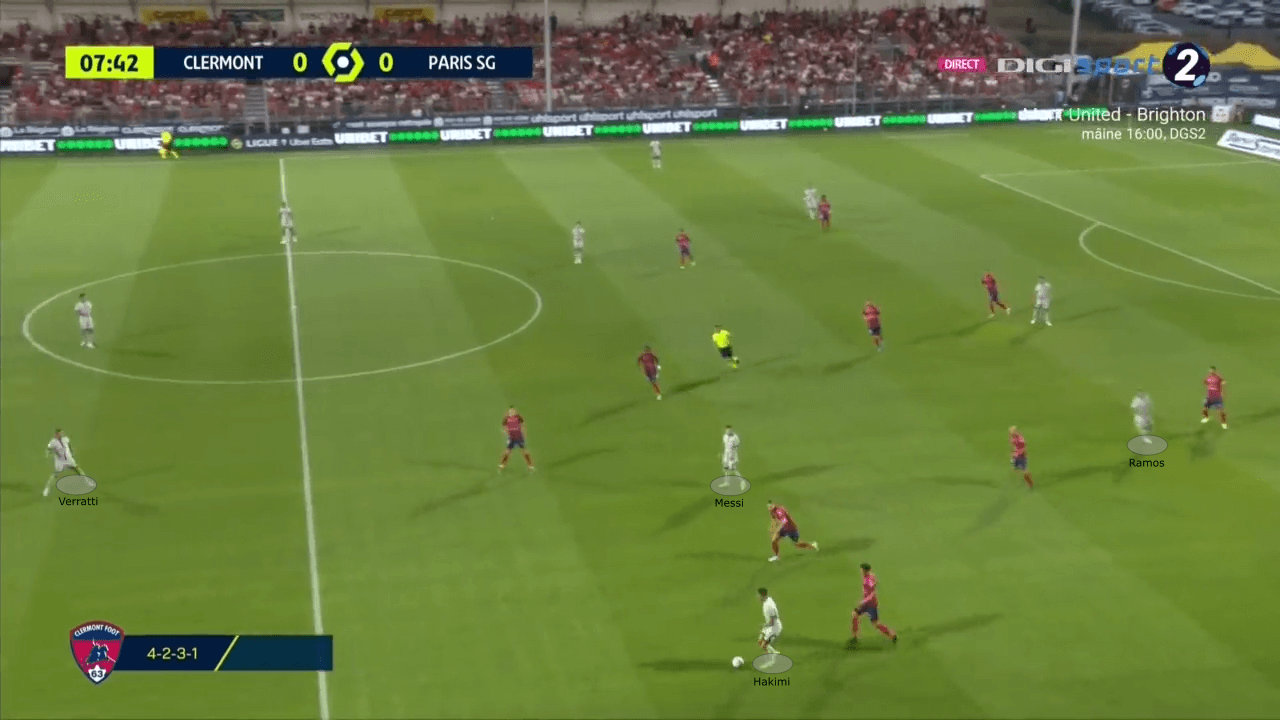
Especially in the final third, this proximity is very effective in creating opportunities. With quick combinations and manipulations off the ball, PSG’s stars can break through low blocks and create chances. In the instance below, Verratti, Neymar, and Messi are able to interact as they enter the box to create a shot opportunity.
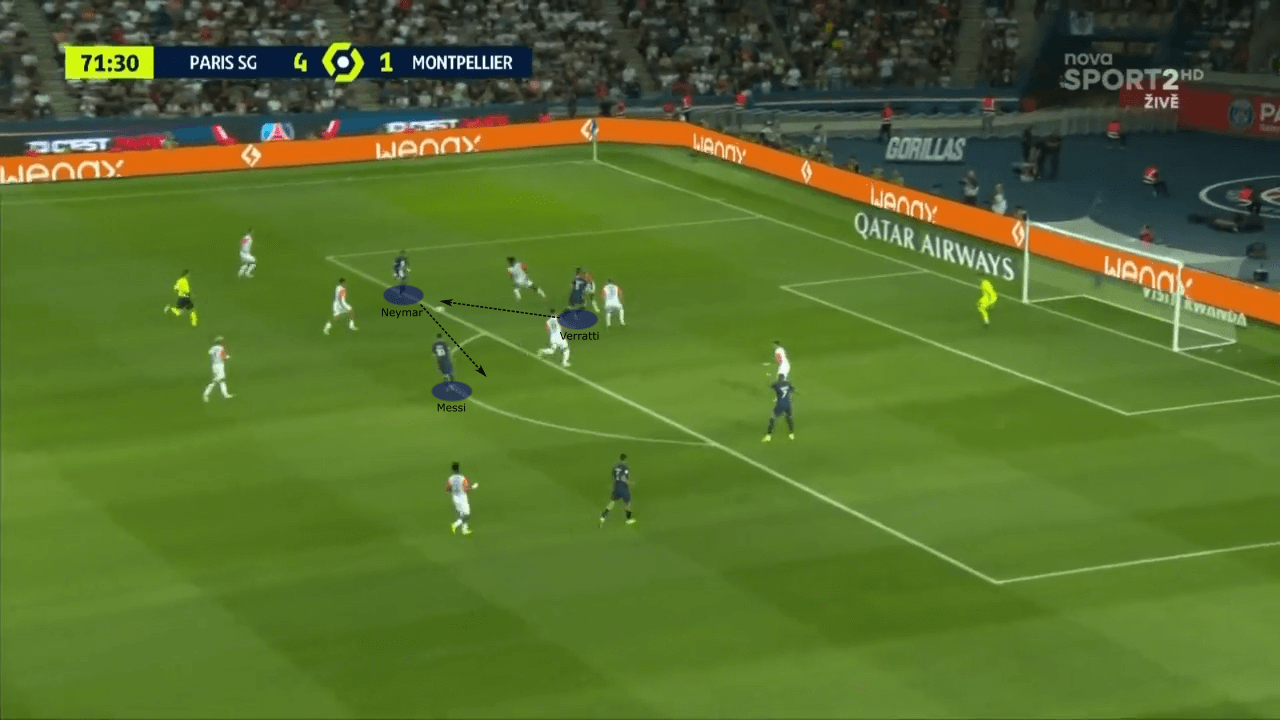
Messi and Neymar
As seen by their recent dominant performances, Galtier’s tactics have proved very effective. In addition to offering a rather uncommon style of play, at least in today’s football, they have maximised PSG’s individual talents in a collective manner. With the effectiveness of low blocks constantly growing in football, space is as limited as ever. While specific tactical strategies are commonly adopted to break down these compact blocks, the French champions have turned to individual talent.
The debate regarding the interaction between tactics and talent was recently brought up in a Pep Guardiola interview, but that is not the aim of this analysis. Paris Saint-Germain have perhaps the most talented attack in world football, but last season’s epic failure proved it is not as simple as plugging them into a tactical system and letting them play.
Their individual characteristics must be heavily taken into consideration, and in order to get the best out of them, the system must be built around them. The structure and tactics adopted by Galtier have seen Messi and Neymar’s performance drastically improve, not only in numbers but also in their interactions.
The duo’s recent performances have been effective and extremely pleasing to watch. In Galtier’s tactics, they are able to interact not only with each other but also with their teammates in a more constructive manner. The two stars thrive on constant interactions with nearby teammates. In systems where players are fairly distant from each other, their performances are not as fruitful.
Additionally, the two possess natural chemistry on the pitch that goes back to their Barcelona days. They are constantly finding each other and combining throughout the pitch. In the example below, Messi is able to play an impressive progressive pass and find Neymar ahead of the backline. As he receives, Vitinha and Nuno Mendes will move near him to provide support.
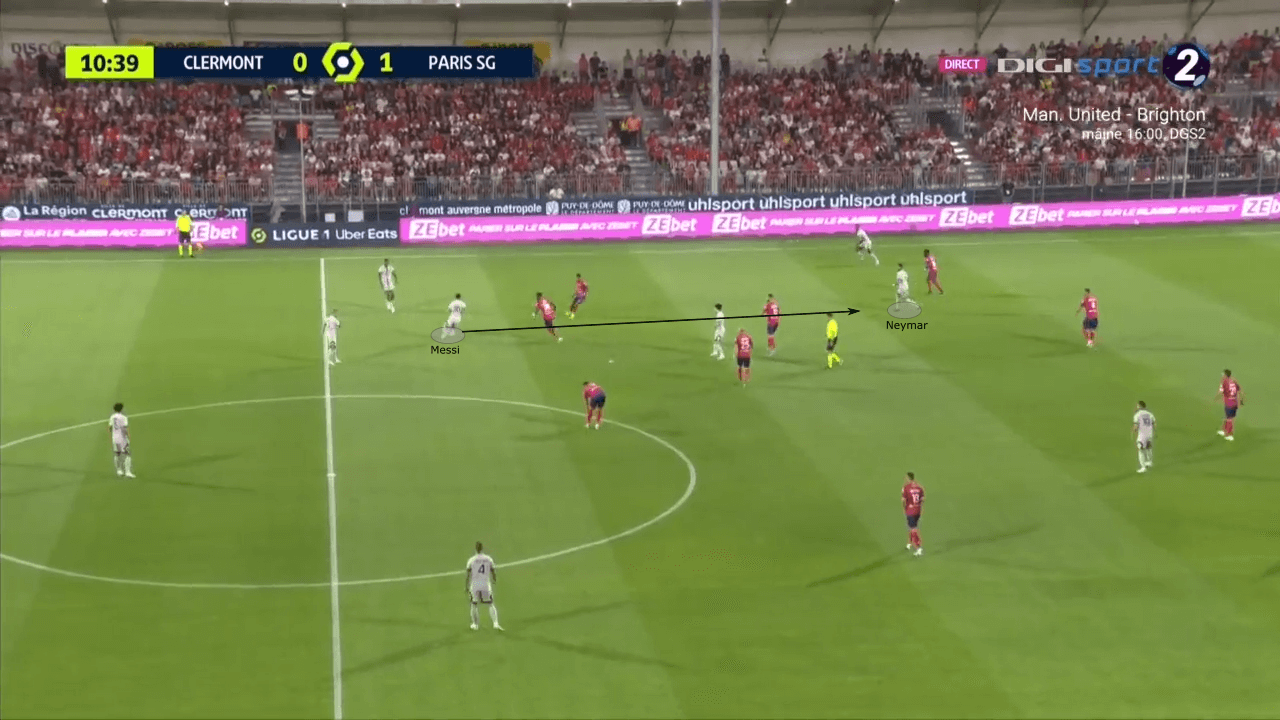
Their interactions prove even more dangerous in the final third. After the first three matches of the season, they have eight goals and four assists combined. Their output has been incredible, and this is a result of their tactical interactions. For instance, against Clermont, Messi can play a nice chip pass to put Neymar in front of the goal.
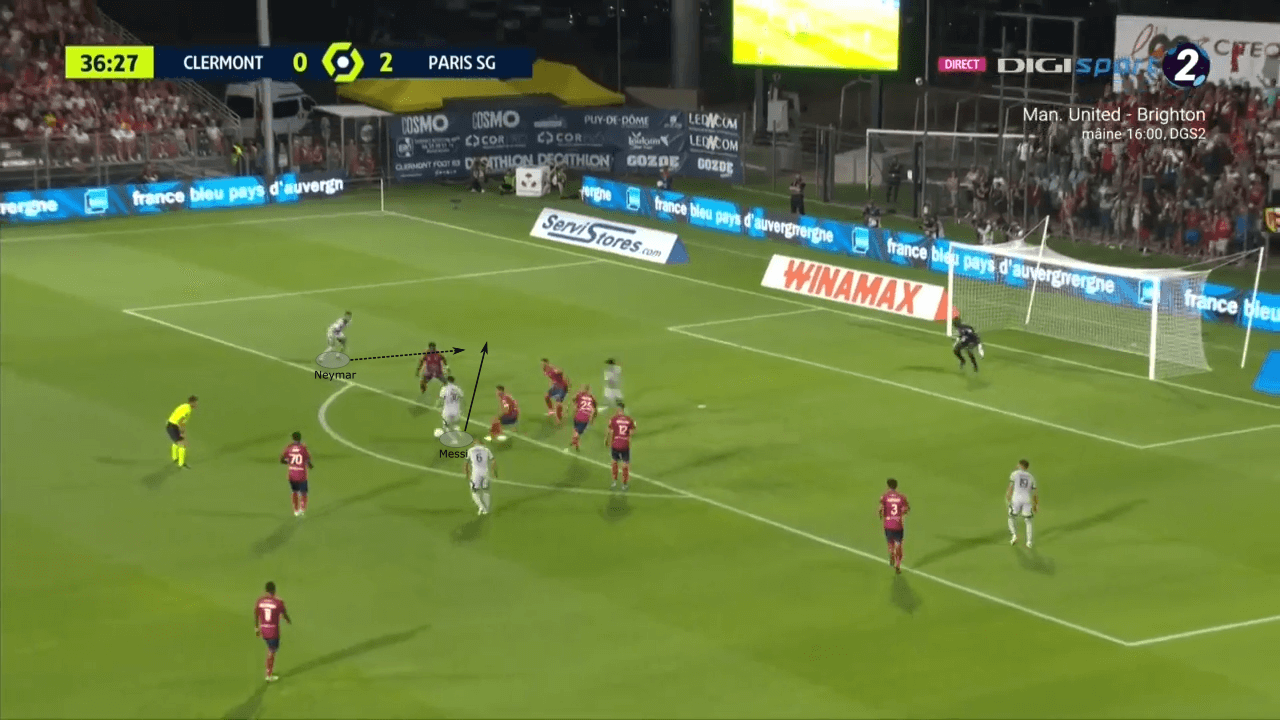
The South American duo also combined for the first goal of the night. As Sarabia played a cutback into the box, Messi, who was aware of Neymar’s presence behind him, slightly flicks it up and prepares it for Neymar to put it in the back of the net.
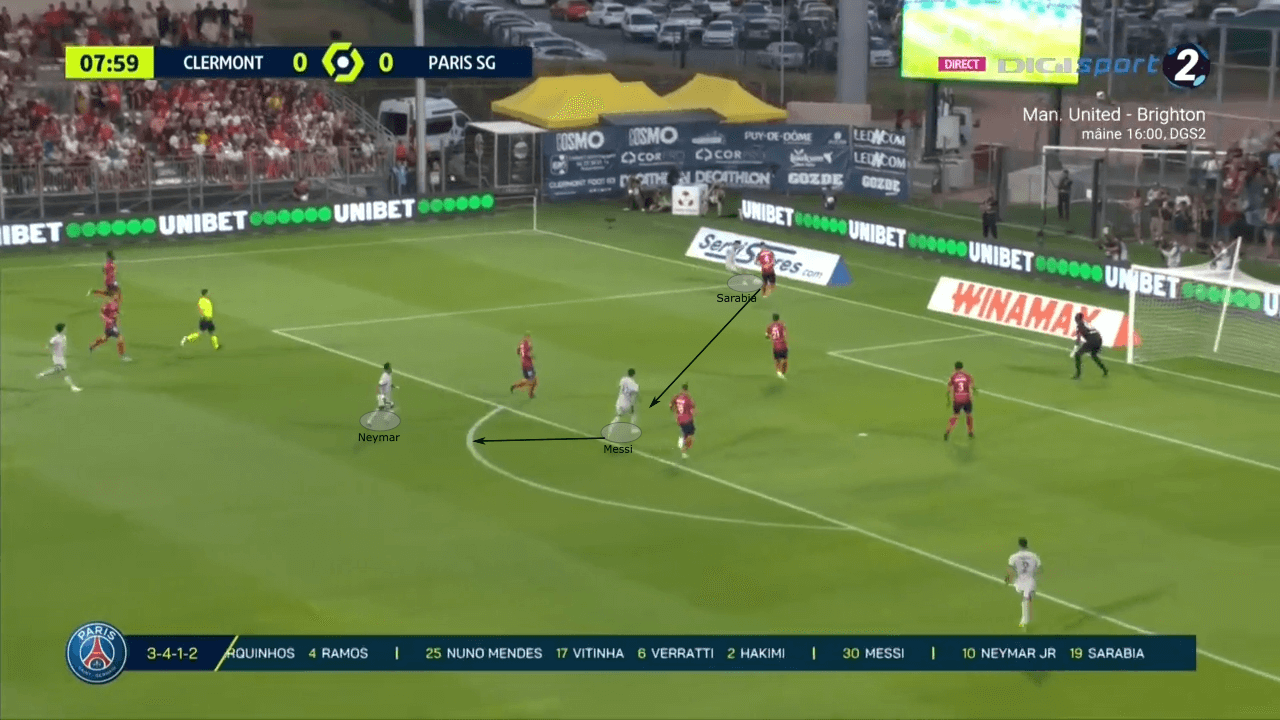
The Mbappé Enigma
While Messi and Neymar have certainly been flourishing together, the same cannot be said for Mbappé. The superstar recently returned to the side against Montpellier and his presence hindered their tactical fluidity. This is mainly because of the Frenchman’s natural characteristics. The first issue can be illustrated by comparing his heatmap against Montpellier to Neymar’s against Nantes. Neymar operated mainly in the left half-space, slightly drifting into the wide and central lanes.
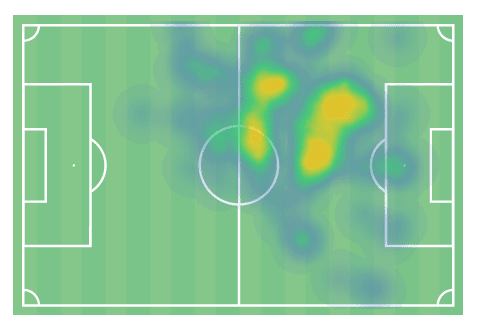
Mbappé’s heatmap is similar as he likes to operate in the same areas. Furthermore, with Nuno Mendes responsible for maintaining width in the attack, Mbappé is not able to drift as wide as he likes to. On the right side, the same issue occurs, except it is with Messi.
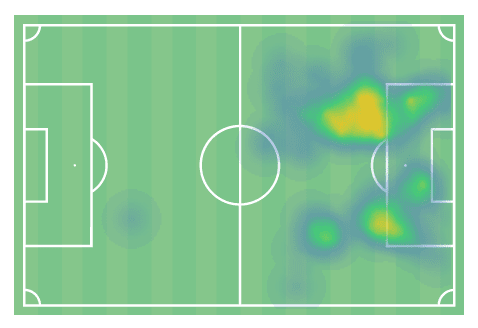
Sarabia had a rather selfless but incredibly significant role in the front three. His movement and positioning provided depth and balance. This depth allowed for the space Messi and Neymar desire to operate in.
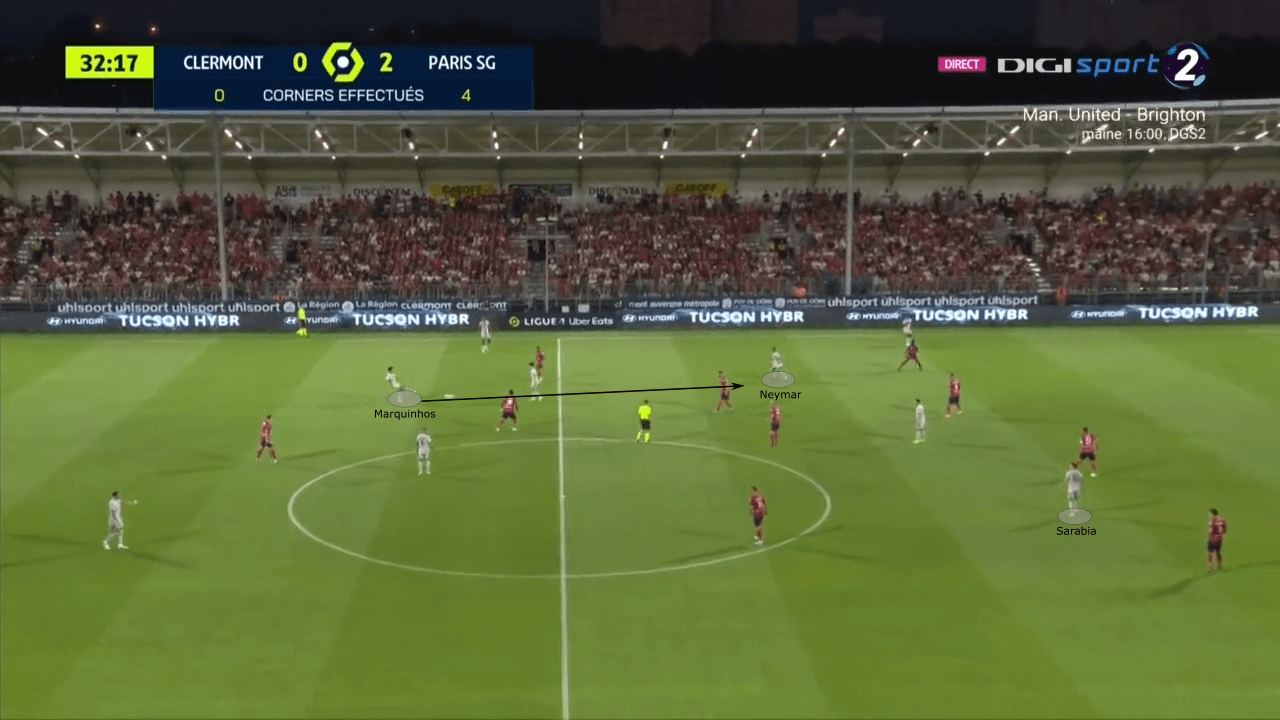
Mbappé, on the other hand, seemed to naturally clash with Neymar. In the instance below, they both check for the ball in the same space. The defender consequently has an easy job as he is able to nullify two players at the same time. Additionally, there is nobody occupying the last defensive line and threatening to attack the space behind. This lack of threat and depth makes it more difficult to create.
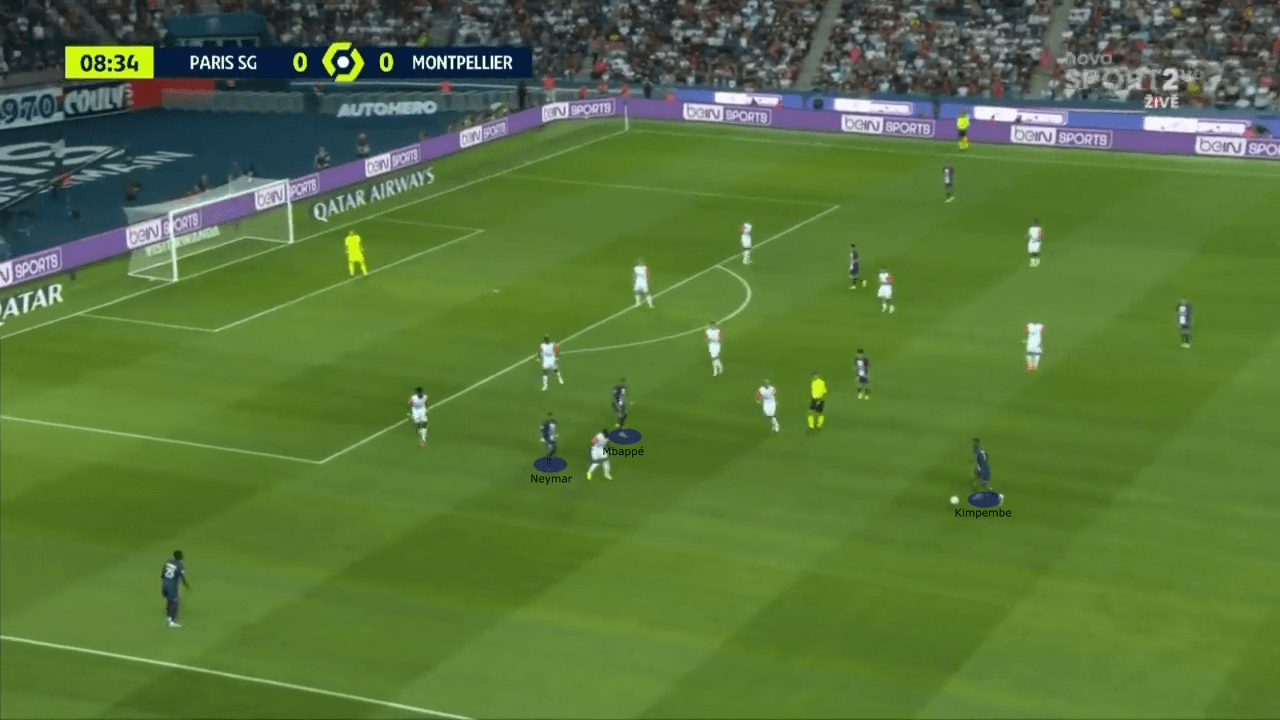
Sarabia is willing to attack this space, even if he will not receive the ball. Attacking the depth naturally lowers the backline and creates more space in between lines for Messi and Neymar to operate. While this is seen with Sarabia, it has been missed of late with Mbappé on the pitch, though this is something Mbappé can provide for the team.
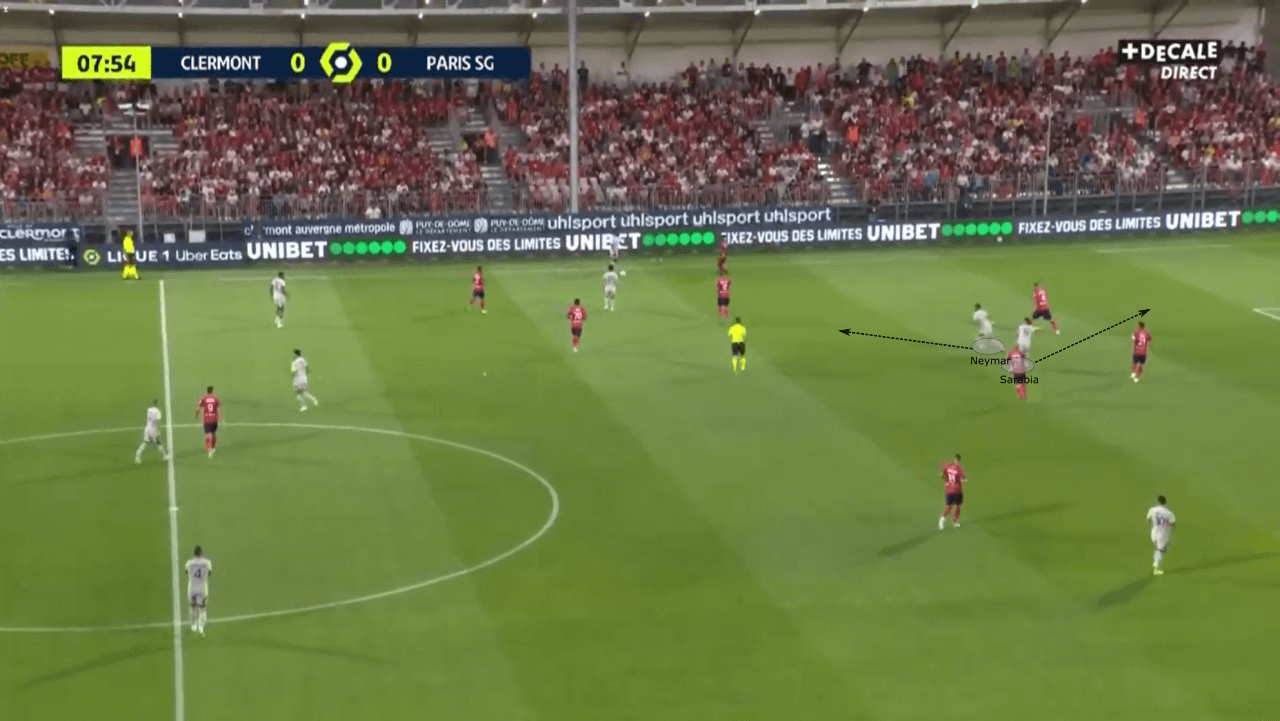
In a more notable example, their lack of depth with Mbappé on the pitch was incredibly significant here. As he wanted to drop in and get on the ball, he limited their threat up front. The opposition’s low block was then able to remain compact without much disruption. Although the match’s elastic result may indicate otherwise, PSG struggled to effectively create in the first half.
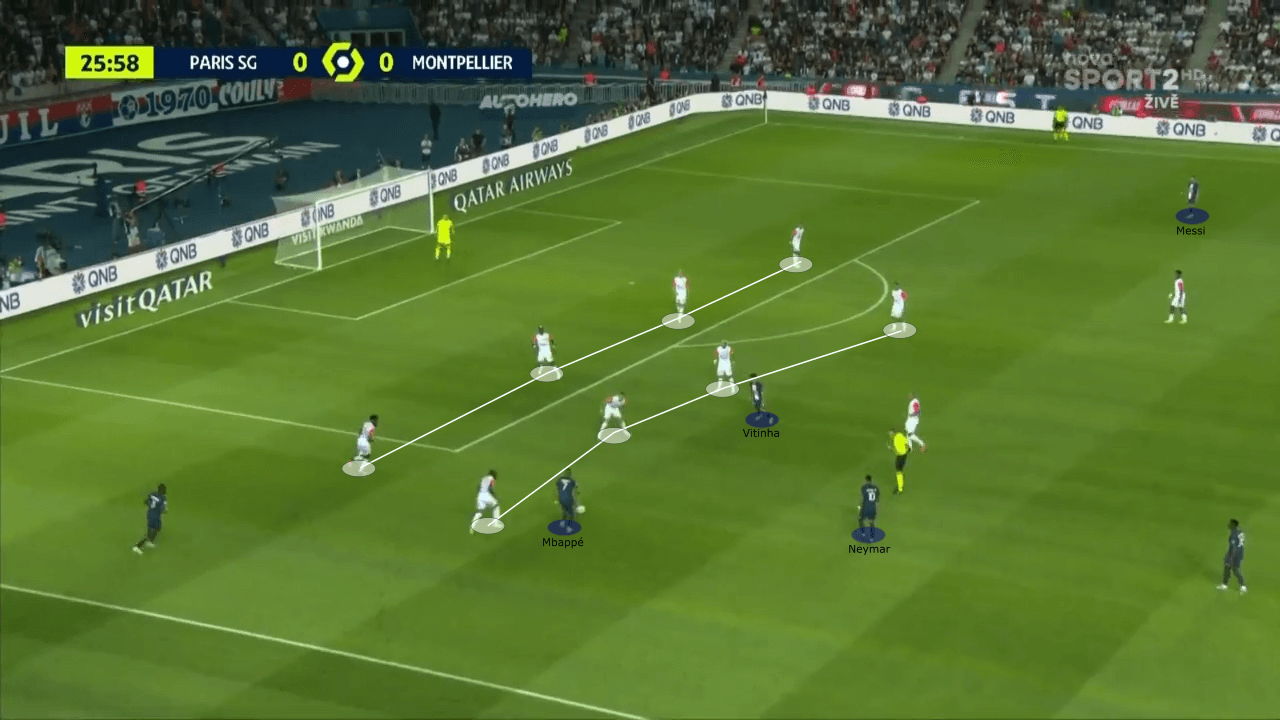
Mbappé is a generational talent and one of the best players in the world. However, his preferences and characteristics, in this context, could provide a tactical problem for Galtier to solve. The French manager is now responsible for solving the last piece of his tactical puzzle and effectively integrating Mbappé into his free-flowing tactics. It will be curious to find out how this is approached, as if successful, Galtier may be able to turn PSG into favourites for the UEFA Champions League title.
Conclusions
Nonetheless, Christophe Galtier has created an exciting tactical system which exploits his superstars’ individual characteristics. So far, it has seemed to get the best out of Messi and Neymar, but the last piece of the puzzle remains. Mbappé’s characteristics will have to be used in a manner that preserves the side’s fluidity and collective dynamic. Although the beginning of last season had higher expectations and more excitement, Galtier’s start at Paris Saint-Germain is looking extremely promising.

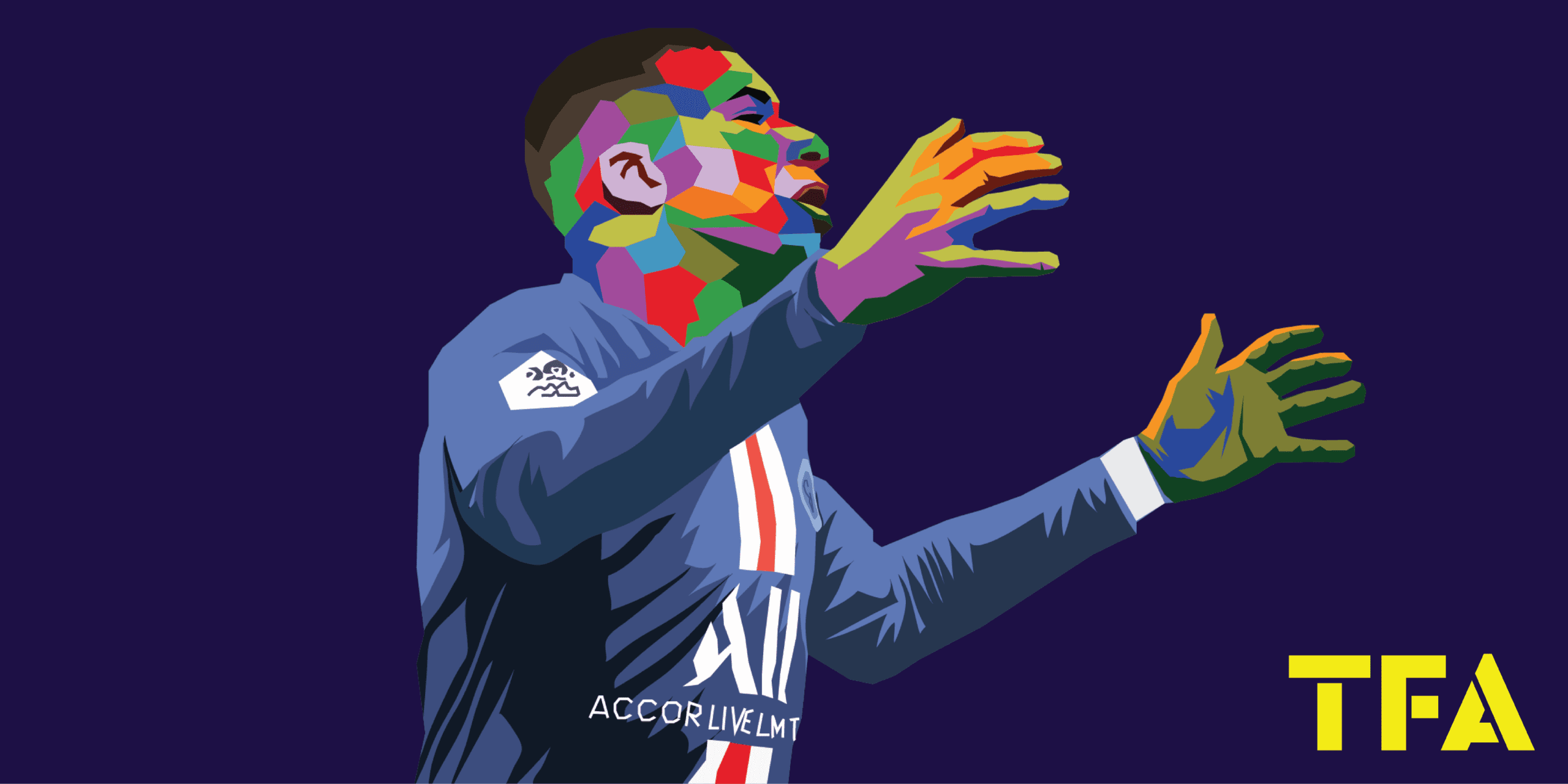



Comments